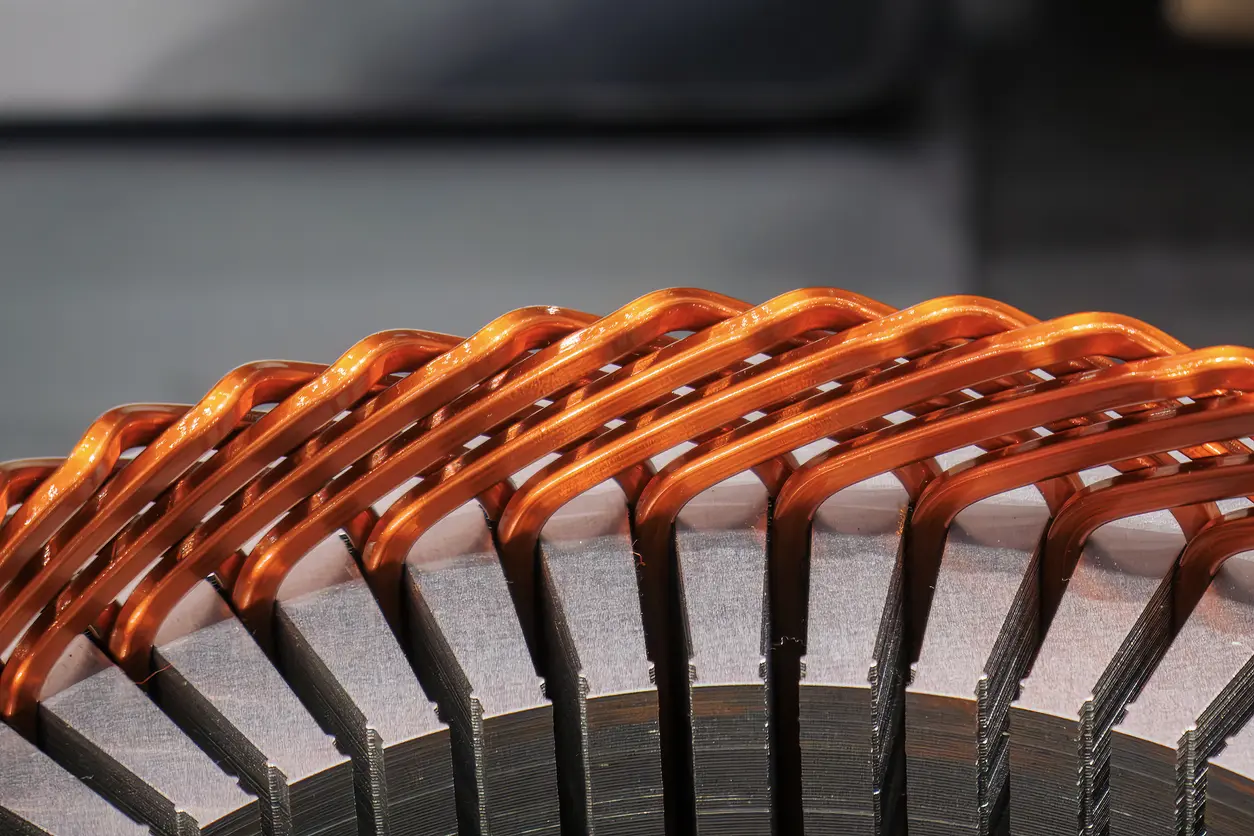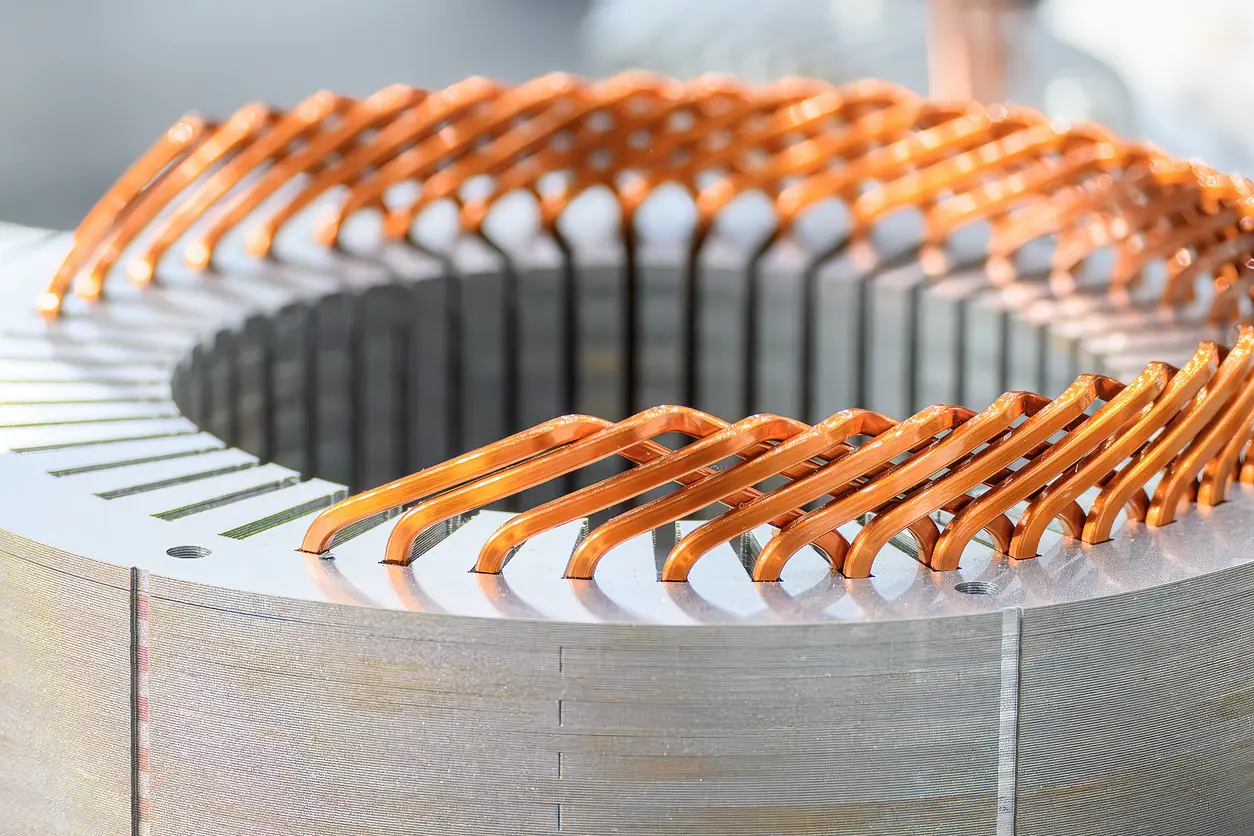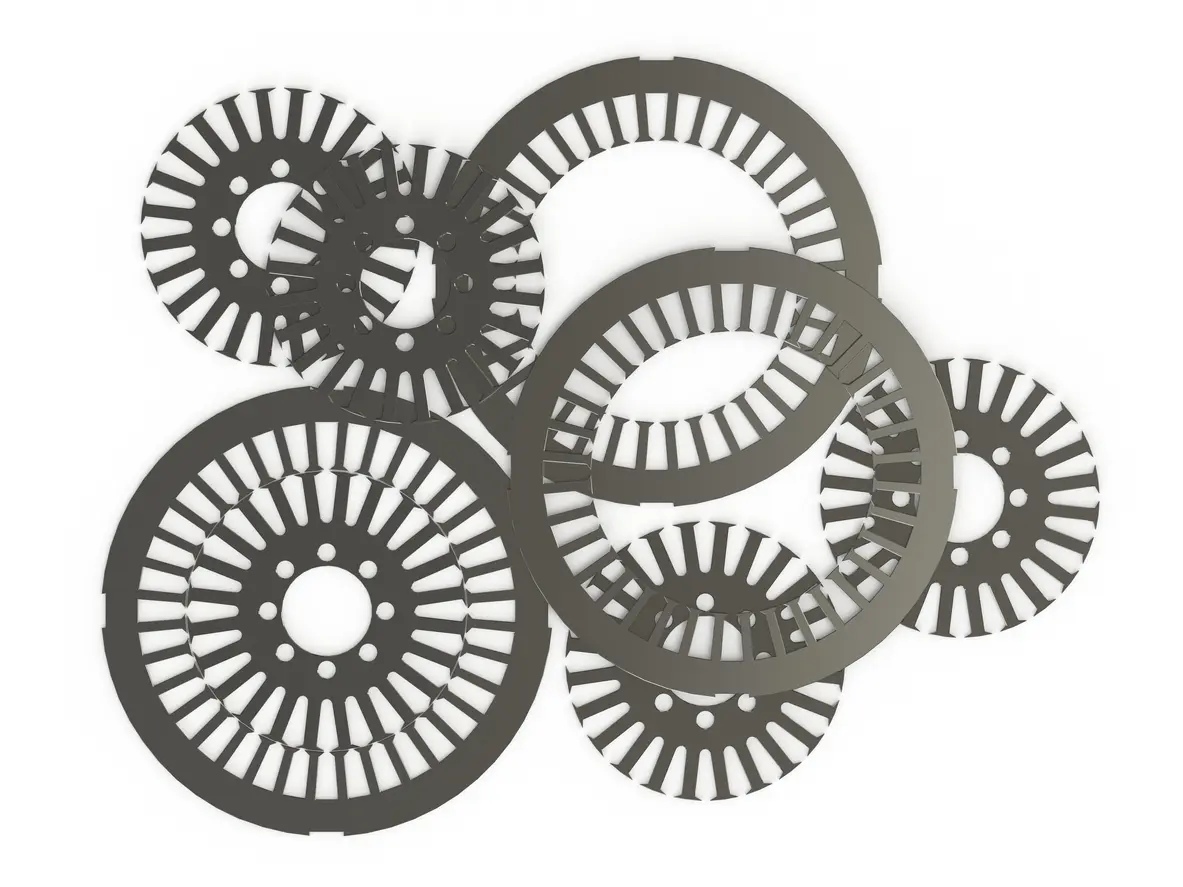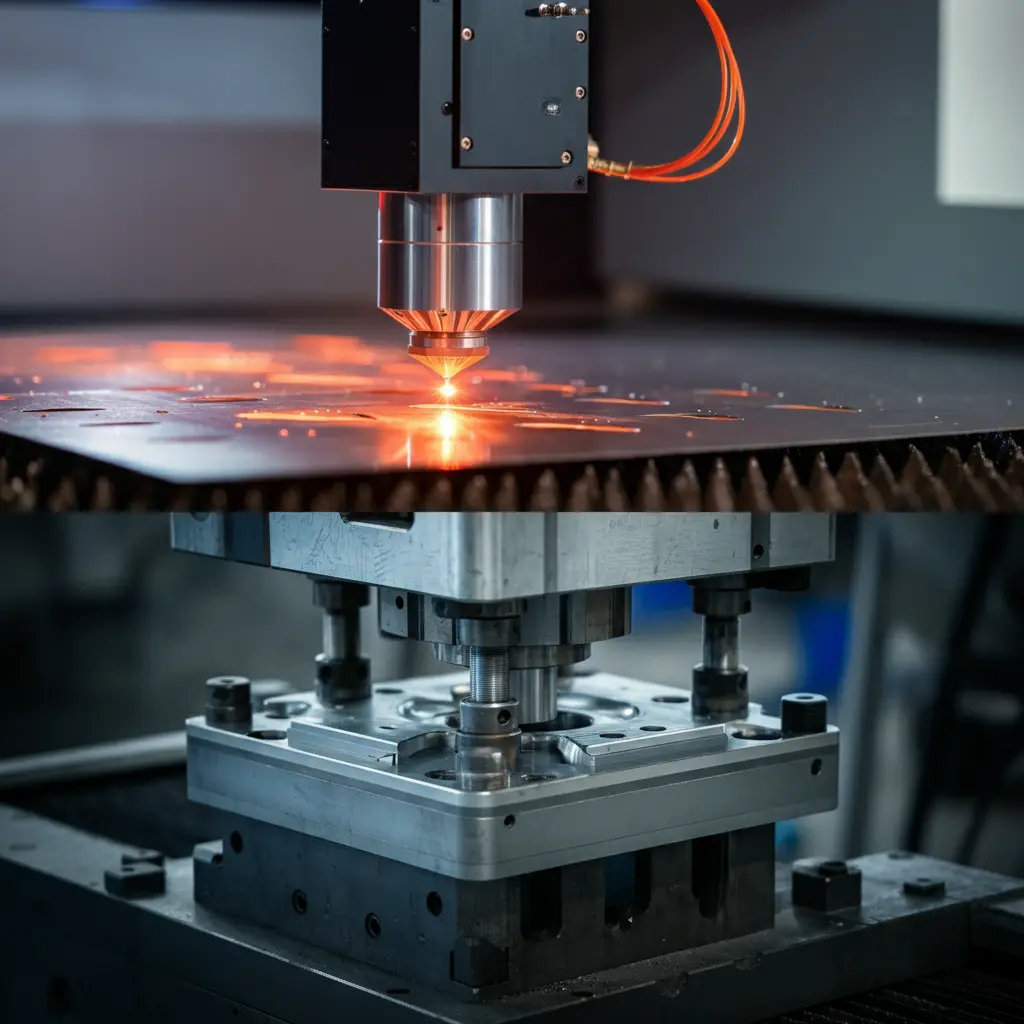Introduction
1.1 Understanding DC Motor Core Lamination
a. Overview of DC motor cores and their critical role in motor performance
A DC motor core is a central component that, along with its lamination layers, forms the foundation of the motor’s magnetic circuit. Although often overlooked, this element’s quality and composition can influence everything from torque output to overall motor reliability. By incorporating carefully selected laminations, engineers can help minimize energy losses, reduce unwanted heat, and improve the consistency of magnetic flux paths.
b. Importance of lamination in reducing eddy current losses and improving efficiency
DC motor core lamination involves stacking thin, insulated steel sheets to decrease eddy currents. Without proper lamination, these circulating currents would waste energy and produce excessive heat. As a result, selecting appropriate lamination materials and thicknesses plays a substantial role in enhancing motor efficiency and performance over the long term.
c. How proper selection contributes to long-term reliability and cost savings
While not all DC motors demand high-end lamination solutions, opting for quality materials and precise assembly techniques can lead to improved longevity. This often translates to reduced maintenance costs, fewer unplanned downtimes, and a more reliable return on investment in the long run.
1.2 Why Selecting the Right DC Motor Core Lamination Matters
a. Impact of core material quality on performance and durability
Choosing the right DC motor core material is not merely about meeting a minimum specification. It also involves ensuring that the selected lamination can endure operational stresses without deformation or premature wear.
b. Influence on operational costs, including energy consumption and maintenance
Ensuring the right lamination quality can help minimize losses and keep energy consumption in check. Over time, such decisions can have a positive effect on expenses related to repairs, part replacements, and downtime.
c. Consequences of overlooking quality factors
When attention to lamination detail is lacking, issues like increased heat, efficiency drops, and accelerated component aging may arise. By considering these aspects, one can avoid unnecessary complications in the motor’s lifecycle.

1. Pitfall #1: Ignoring Material Composition and Quality
1.1 Failing to Assess Core Material Grades
a. Difference between standard and high-grade silicon steel laminations
When selecting DC motor core lamination, it can be tempting to opt for more common or easily available materials. However, not all silicon steel laminations are created equal. Standard-grade materials may appear sufficient at first glance, but high-grade silicon steel tends to yield lower losses and improved magnetic properties. This difference can influence how efficiently the motor converts electrical energy into mechanical output.
b. Importance of proper silicon content to reduce core losses and improve magnetic permeability
The level of silicon content within the steel directly affects the permeability and core losses of the lamination. Carefully chosen silicon levels help reduce undesirable heat generation and enhance the motor’s overall durability. Ignoring this factor could lead to suboptimal performance and potentially shorter operational life.
c. Ensuring consistent material thickness and quality
Variation in thickness or material quality can undermine the entire DC motor core lamination assembly. Consistency ensures reliable magnetic performance, improved longevity, and reduced operational issues down the line.
1.2 Overlooking Supplier Certifications and Standards
a. Relevance of ISO certifications and recognized industry standards
Reliable suppliers follow strict manufacturing standards. ISO certifications and other recognized standards act as important indicators of product consistency, making it more likely that your DC motor core lamination meets essential performance criteria.
b. Verifying material origin and grade consistency
Inquiring about the material’s origin and grade can help ensure that every batch is stable and predictable. Consistent inputs ultimately lead to consistent results in motor operation.
c. Leveraging supplier audits and material traceability
Audits and traceability processes encourage accountability. With thorough documentation, it becomes easier to identify, address, and prevent issues that might diminish the reliability or efficiency of the DC motor core lamination.
1.3 Not Prioritizing Core Loss and Saturation Testing
a. The importance of conducting Epstein frame tests or similar evaluations
Testing methods, such as Epstein frame tests, objectively measure core losses. This data guides informed decisions about which lamination materials will achieve desired performance goals.
b. Evaluating core saturation levels and their impact on efficiency
Excessive saturation can affect efficiency. Proper testing before full-scale production helps ensure that the chosen material and design strike the right balance.
c. Partnering with suppliers that provide transparent test results
Transparency builds trust. Working with suppliers who readily share test results helps you make better-informed choices, reducing long-term risks in DC motor core lamination selection.
2. Pitfall #2: Neglecting Proper Lamination Stacking Techniques
2.1 Underestimating the Significance of Stacking Quality
a. How poor stacking leads to uneven flux distribution and vibration
If the layers of a DC motor core lamination are not carefully aligned and secured, even slight misalignments can cause uneven magnetic flux distribution. In practice, this may translate into higher levels of vibration, noise, and reduced motor smoothness. While minor deviations might seem inconsequential, they can accumulate over time, affecting overall performance and durability.
b. Risks of improper burr removal and lamination misalignment
When burrs—small metal projections left behind after the cutting process—are not properly removed, laminations may not stack evenly. Such imperfections can disrupt the uniform magnetic pathways essential for efficient motor operation. Maintaining a careful inspection process and employing suitable deburring methods can help ensure each DC motor core lamination layer contributes positively to the motor’s flux field.
c. Effects on noise levels and premature wear
Inadequate stacking often increases mechanical friction and resonance, resulting in additional noise and vibration. Over the long term, this may accelerate wear on bearings and other components, potentially shortening the motor’s life span.
2.2 Overlooking Stacking Factor and Tightness
a. Understanding the stacking factor’s role in magnetic efficiency
The stacking factor—the ratio of steel to non-steel space—directly influences the efficiency of a DC motor core lamination stack. Achieving a high stacking factor ensures a denser, more uniform magnetic path, which can contribute to improved motor performance and stability.
b. The dangers of loose stacks causing internal movement and friction
If the lamination stack is not tightly assembled, internal movement can occur, creating frictional losses and heat buildup. Over time, such conditions may reduce efficiency and reliability.
c. Using advanced tooling and automated processes for precise assembly
By employing advanced tooling methods and, where practical, automated stacking solutions, manufacturers can achieve greater precision, consistency, and repeatability. Such approaches may help ensure that each DC motor core lamination stack meets the desired performance standards.
2.3 Failing to Incorporate Specialized Bonding Methods
a. Benefits of interlocking, welding, or bonding techniques for lamination stability
Techniques such as interlocking or spot welding can secure laminations more effectively, preventing slippage or misalignment. Careful selection of bonding methods supports a stable, cohesive stack.
b. Balancing cost with improved structural integrity
While certain bonding methods may introduce additional costs, the long-term stability, improved efficiency, and reduced maintenance could justify the initial investment.
c. Partnering with experienced manufacturers for advanced lamination assembly methods
Working with reliable suppliers who have a track record of delivering high-quality DC motor core lamination assemblies can help ensure consistent results. Their expertise, combined with robust quality control practices, reduces the risk of issues arising from improper stacking.
3. Pitfall #3: Disregarding Customization and Design Flexibility
3.1 Relying Solely on Standard Off-the-Shelf Laminations
a. Limitations of generic designs in meeting specific performance needs
When dealing with DC motor core lamination, relying exclusively on standard, off-the-shelf designs can sometimes limit the potential benefits your system might achieve. Although such laminations may appear cost-effective initially, they may not be the best fit for unique performance requirements.
b. Potential mismatch with motor dimensions and required tolerances
Generic lamination configurations may not align perfectly with your motor’s dimensions or necessary tolerances. Even slight discrepancies in thickness or shape can affect magnetic pathways, reduce efficiency, or introduce unnecessary noise and vibration. Ensuring that the lamination matches the exact needs of your application could potentially improve long-term operational reliability.
c. Missing out on opportunities for performance optimization
Opting for a standardized approach may mean overlooking opportunities to enhance energy efficiency, longevity, or motor stability. Customizing DC motor core lamination elements can open doors to more precise magnetic characteristics and better overall function.
3.2 Not Consulting with Engineering Teams for Tailored Solutions
a. Collaborative design approaches for optimal magnetic efficiency
Working closely with engineering teams and material specialists can help identify lamination designs that precisely match your motor’s intended performance. Such collaboration often leads to improved magnetic efficiency and smoother operation.
b. Adjusting lamination thickness, geometry, and material based on unique requirements
Design flexibility allows for fine-tuning factors like lamination thickness, geometry, and material composition. By considering these adjustments, you may prevent unnecessary losses and address issues before they become costly in production.
c. Shortening development cycles through close manufacturer-customer cooperation
Proactive communication with experienced manufacturers can streamline the development process, potentially shortening lead times. Early involvement ensures that both parties remain aligned on objectives.
3.3 Overlooking Prototype Testing and Iterations
a. The value of rapid prototyping and iterative design improvements
Before committing to full-scale production, creating prototypes and implementing iterative design improvements can highlight areas needing refinement. Such steps are often pivotal in ensuring that DC motor core lamination meets exact specifications.
b. Detecting and resolving design flaws before full-scale production
By identifying and resolving potential design flaws early, manufacturers and customers can avoid issues that might only emerge later in the motor’s lifespan. Early fixes may help maintain efficiency and reduce operational costs.
c. Reducing long-term costs by investing in early-stage innovation
A thoughtful, iterative approach to lamination design usually pays off. By investing in customization and thorough testing at the onset, you could avoid expensive rework, unplanned maintenance, or premature part replacements over time.
4. Pitfall #4: Underestimating Quality Control and Inspection Processes

4.1 Skipping Comprehensive Dimensional Tolerances Checks
a. Ensuring laminations meet strict dimensional tolerances to maintain motor efficiency
Even the most carefully selected DC motor core lamination materials can fall short of expectations if dimensional tolerances are not meticulously verified. Keeping dimensional consistency within tight specifications is critical to preserving optimal magnetic flux paths and minimizing unnecessary energy losses.
b. Using precision measuring equipment and automated inspection systems
Relying on manual measurements or outdated tools may introduce human error and inconsistencies. Employing advanced measuring devices and automated inspection systems can help ensure that each DC motor core lamination meets established criteria, ultimately supporting more stable and efficient motor operation.
c. Avoiding long-term inefficiencies and mechanical inconsistencies
Variations in thickness, alignment, or shape can accumulate over time, contributing to performance decline, increased vibration, and even premature wear. By emphasizing dimensional control, the risk of long-term inefficiencies is significantly reduced.
4.2 Neglecting Surface Finish and Coating Quality
a. Importance of proper surface treatments (e.g., insulating varnishes)
The quality of a DC motor core lamination is not determined solely by its base material. Adequate surface finishes and insulating varnishes play a critical role in reducing eddy currents and controlling heat generation.
b. Preventing eddy current losses and corrosion through quality coatings
Proper coatings create a protective barrier that enhances electrical insulation. Without this safeguard, corrosion and increased eddy current losses may compromise both performance and longevity.
c. Consistent finishing methods to maintain insulation properties
A stable, uniform finish helps the lamination stack maintain its insulation characteristics. Ensuring that all laminations receive identical treatment can support improved reliability and reduced maintenance costs.
4.3 Overlooking Final Assembly Validation and Run-In Tests
a. Conducting in-house or third-party performance tests on assembled cores
Before finalizing production, it is often prudent to conduct comprehensive testing—either internally or via reputable third parties. These evaluations confirm that the assembled DC motor core lamination stack performs as intended.
b. Identifying minor defects before mass production and distribution
By detecting small flaws early, manufacturers can prevent them from becoming larger issues. This proactive approach can help save time, reduce warranty claims, and protect the company’s reputation.
c. Using statistical process control (SPC) and Six Sigma methodologies
Structured quality frameworks, such as SPC and Six Sigma, offer data-driven insights into process variability. Applying these methodologies can refine quality control strategies, ensuring that the DC motor core lamination consistently meets performance standards.
Conclusion
6.1 Recap of Key Takeaways
Throughout this discussion, we have explored some of the most common pitfalls to avoid when working with DC motor core lamination. By placing an emphasis on material composition, ensuring proper stacking techniques, considering customization options, and maintaining rigorous quality control measures, it is possible to significantly improve the performance, reliability, and longevity of your motor solutions. Each of these four areas plays a critical role in achieving the kind of motor efficiency and durability that will stand the test of time. Although there may be no universal formula for perfection, being aware of these potential issues can lay a solid foundation for more informed decision-making.
6.2 Steps to Make Informed Choices
It can be beneficial to approach DC motor core lamination selection in a measured, analytical manner. Begin by verifying material grades and testing core losses before investing in large-scale production. Engaging in dialogue with suppliers about their certifications, traceability practices, and quality assurance procedures can help ensure that you are building a partnership rooted in transparency and reliability. Next, address stacking techniques and customization strategies early in the design process. Collaborative prototyping, expert consultation, and iterative testing can guide you toward more tailored lamination solutions that align with your motor’s unique operational profile. Finally, never underestimate the value of thorough inspection protocols and proper finishing methods.
6.3 Encouraging Proactive Measures
Rather than viewing the selection of DC motor core lamination as a one-time decision, consider it part of a continuous improvement process. Monitor performance data over time, explore incremental material or design enhancements, and remain open to innovative manufacturing methods as they emerge. Even small adjustments can, over the long term, contribute to meaningful gains in efficiency and cost-effectiveness. By remaining vigilant, well-informed, and open to ongoing refinements, you can help ensure that the DC motor core lamination you select will support strong, sustainable performance well into the future.
Further Reading About DC motor:
https://shop.islproducts.com/design-and-construction-of-dc-motors/





